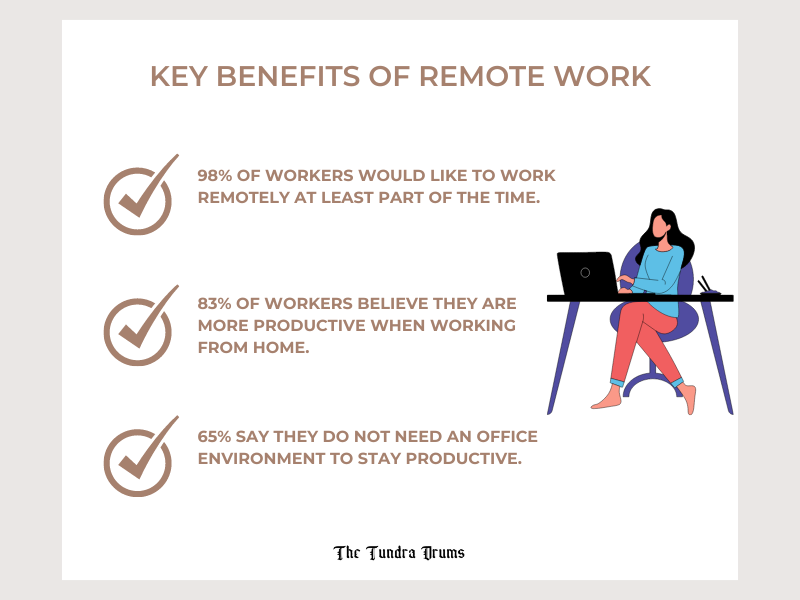As the world changes, so does the way we work. Remote work technology has become essential in today’s job market. It is not just a short-term trend but a long-term solution that benefits businesses and employees. In this blog post, we will explore why remote work technology is critical, how it impacts different industries, and what the future holds for this work style.
What is Remote Work Technology?
Remote work technology includes the tools and systems that allow employees to do their jobs outside the traditional office. This can include:
- Video conferencing tools like Zoom or Microsoft Teams.
- Project management software like Asana or Trello.
- File-sharing platforms like Google Drive or Dropbox.
- Cloud-based applications that can be accessed from anywhere.
These technologies have enabled people to work efficiently from their homes, coffee shops, or anywhere with an internet connection.
The Current Statistics of Remote Work 2024
- As of 2024, 14% of full-time employees are entirely remote, while 29% work in a hybrid model, splitting their time between home and office, and 57% remain fully in-office.
- 19.5% of Americans (about 30 million) worked remotely as of September 2023.
This shows a significant increase in remote work, and it’s expected to continue growing in the coming years.
Hybrid Work Model:
Currently, 28.2% of employees use a hybrid work model. This means they spend part of their time working from home and the rest in the office.
Hybrid models offer flexibility, allowing workers to enjoy the benefits of remote work while still having time for in-person collaboration when needed.
Why Do Employees Prefer Remote Work?
Remote work has many advantages, especially regarding employee satisfaction and productivity.

These statistics highlight that remote work helps workers perform better and feel happier, which is why it’s so popular.
Why has Remote Work Technology Become a Need for the Future?
Remote work technology improves productivity, employee satisfaction, and business flexibility. Here are key reasons why it’s vital:
- Boosts Productivity: Remote workers can be up to 47% more productive due to no commute and a personalized work environment.
- Global Talent Access: Companies can hire skilled workers from anywhere, creating a more inclusive workforce.
- Cost Savings: Both businesses and employees save money, companies on office expenses and employees on commuting and daily costs.
- Improved Work-Life Balance: Flexible schedules allow employees to manage personal and professional responsibilities, reducing stress.
- Resilience During Disruptions: Remote work systems help companies stay operational during crises like the COVID-19 pandemic.
- Advanced Technology: AI and cloud tools are making remote work more accessible and efficient for teams.
How Does Remote Work Impacts Productivity?

Remote work technology plays a massive role in helping employees stay productive. Workers can focus more on tasks without requiring long commutes and office distractions. Companies that have embraced remote work are already seeing results:
- 63% of businesses that updated their benefits packages after transitioning to remote work saw increased productivity.
- 47% of business leaders now allow employees to work from home full-time.
Industry Trends and Remote Work

The technology sector leads the way. Remote work is also popular in the tech industry:
- In 2023, 67% of employees in the tech industry are working remotely.
- By 2028, 73% of departments across various industries will include remote workers.
The technology sector has quickly adapted to remote work, and other industries are following suit. Remote work is no longer limited to specific jobs. It’s becoming a standard part of the workplace.
Challenges of Remote Work: Promotions and Job Security
While working from home has many benefits, it also presents some challenges. Some studies show that remote workers may face disadvantages compared to their in-office colleagues:
- Remote workers are 31% less likely to receive promotions.
- They are also 35% more likely to face layoffs.
This highlights the need for businesses to address these challenges to ensure that remote employees are not left behind in career growth and job security.
Global Trends in Remote Work
| Year | Percentage of Global Workforce Working Remotely |
| 2020 | 20% |
| 2023 | 28% |
The global remote workforce has grown by 8% in just three years, reflecting the worldwide shift towards flexible work arrangements. Even industries that traditionally require in-person work, like healthcare, are seeing an increase in remote work:
In healthcare, 17% of workers (about 2.7 million) telecommute.
Flexibility is the Future
One of the biggest reasons remote work is famous is its flexibility. Many employees are choosing jobs based on whether they allow remote work. Surveys show that:
66% employees said having flexible schedules is the most important part of a remote work model.
This means that companies need to offer more flexible work options to attract and retain top talent.
How Remote Work Technology is Changing the Workplace?
The rise of remote work technology is changing how we think about the workplace. Here are some ways it is making a difference:
- Cost savings for businesses: When employees work remotely, companies save money on office space, utilities, and other expenses.
- Better work-life balance for employees: Workers have more control over their time, leading to less stress and better mental health.
- Broader talent pool: Businesses can hire talent from anywhere globally, not just in their local area.
The Future of Remote Work

Remote work is here to stay. As more businesses benefit from remote work technology, it will become even more common. With the development of 6G technology, the future of remote work will see even faster internet speeds and improved network reliability, enabling more advanced tools for seamless virtual collaboration. Here are some predictions for the future:
- By 2025, 36.2 million American employees will be working remotely.
- By 2028, almost 73% of all departments across industries will include remote workers.
Businesses that need to adapt to this new way of working avoid falling behind. They must invest in the right tools and create policies supporting remote work to remain competitive.
Final Words
Remote work technology is not just a trend; it’s the future of work. It offers flexibility, improves productivity, and allows businesses to hire the best talent from anywhere in the world. As more companies adopt these tools, remote work will continue to grow, shaping the future of how we work.
FAQs
Why is remote work technology important for productivity?
Remote work technology helps people be more productive. Studies show that remote workers can be up to 22% more productive and often work about three extra hours each week because they don’t have to commute or attend as many in-person meetings.
How does remote work technology make employees happier?
Many remote workers feel happier and less stressed. 80% of them say they feel less stressed when working from home. This is mainly because they can manage their time better and avoid long commutes.
What are the money-saving benefits of remote work?
Remote workers save around $4,000 yearly on commuting, lunches, and work clothes. Companies also save money on office space and utilities when employees work from home.
How does remote work help companies find diverse talent?
Remote work allows companies to hire people from anywhere in the world. This means they can find a broader range of talent, including individuals with disabilities who may find it easier to work from home.
How do remote teams stay connected?
Remote teams communicate using tools like video calls and project management apps. Research shows that teams using these tools are 158% more engaged and 61% more likely to stay with their company compared to those who don’t use these technologies.
Why is remote work technology essential for keeping businesses running?
Good remote work systems allow companies to continue operating during emergencies like pandemics or natural disasters. Businesses that used remote work during COVID-19 were able to maintain productivity and keep their employees engaged.
What future changes can we expect in remote work technology?
In the future, we might see more advanced tools like artificial intelligence for automating tasks and better security measures to protect data. Also, about 73% of workers prefer having flexible work locations over getting a pay raise, showing a strong desire for continued remote work options.












